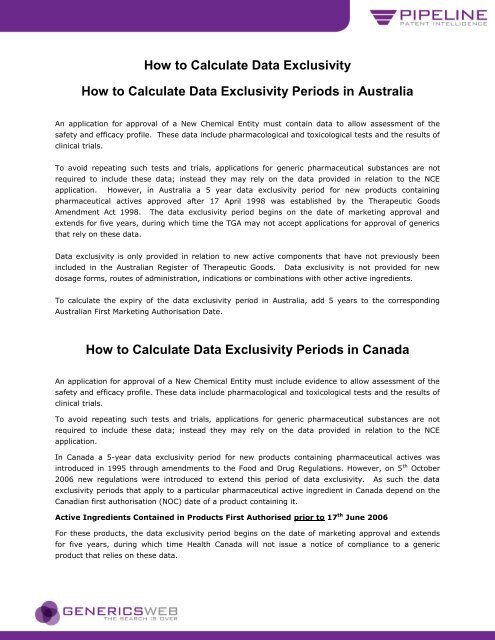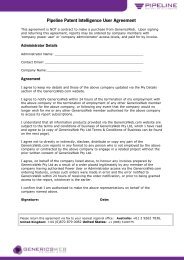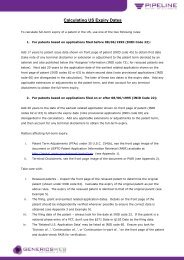How to Calculate Standard Patent Expiry Dates and ... - GenericsWeb
How to Calculate Standard Patent Expiry Dates and ... - GenericsWeb
How to Calculate Standard Patent Expiry Dates and ... - GenericsWeb
Create successful ePaper yourself
Turn your PDF publications into a flip-book with our unique Google optimized e-Paper software.
<strong>How</strong> <strong>to</strong> <strong>Calculate</strong> Data Exclusivity<br />
<strong>How</strong> <strong>to</strong> <strong>Calculate</strong> Data Exclusivity Periods in Australia<br />
An application for approval of a New Chemical Entity must contain data <strong>to</strong> allow assessment of the<br />
safety <strong>and</strong> efficacy profile. These data include pharmacological <strong>and</strong> <strong>to</strong>xicological tests <strong>and</strong> the results of<br />
clinical trials.<br />
To avoid repeating such tests <strong>and</strong> trials, applications for generic pharmaceutical substances are not<br />
required <strong>to</strong> include these data; instead they may rely on the data provided in relation <strong>to</strong> the NCE<br />
application. <strong>How</strong>ever, in Australia a 5 year data exclusivity period for new products containing<br />
pharmaceutical actives approved after 17 April 1998 was established by the Therapeutic Goods<br />
Amendment Act 1998. The data exclusivity period begins on the date of marketing approval <strong>and</strong><br />
extends for five years, during which time the TGA may not accept applications for approval of generics<br />
that rely on these data.<br />
Data exclusivity is only provided in relation <strong>to</strong> new active components that have not previously been<br />
included in the Australian Register of Therapeutic Goods. Data exclusivity is not provided for new<br />
dosage forms, routes of administration, indications or combinations with other active ingredients.<br />
To calculate the expiry of the data exclusivity period in Australia, add 5 years <strong>to</strong> the corresponding<br />
Australian First Marketing Authorisation Date.<br />
<strong>How</strong> <strong>to</strong> <strong>Calculate</strong> Data Exclusivity Periods in Canada<br />
An application for approval of a New Chemical Entity must include evidence <strong>to</strong> allow assessment of the<br />
safety <strong>and</strong> efficacy profile. These data include pharmacological <strong>and</strong> <strong>to</strong>xicological tests <strong>and</strong> the results of<br />
clinical trials.<br />
To avoid repeating such tests <strong>and</strong> trials, applications for generic pharmaceutical substances are not<br />
required <strong>to</strong> include these data; instead they may rely on the data provided in relation <strong>to</strong> the NCE<br />
application.<br />
In Canada a 5-year data exclusivity period for new products containing pharmaceutical actives was<br />
introduced in 1995 through amendments <strong>to</strong> the Food <strong>and</strong> Drug Regulations. <strong>How</strong>ever, on 5 th Oc<strong>to</strong>ber<br />
2006 new regulations were introduced <strong>to</strong> extend this period of data exclusivity. As such the data<br />
exclusivity periods that apply <strong>to</strong> a particular pharmaceutical active ingredient in Canada depend on the<br />
Canadian first authorisation (NOC) date of a product containing it.<br />
Active Ingredients Contained in Products First Authorised prior <strong>to</strong> 17 th June 2006<br />
For these products, the data exclusivity period begins on the date of marketing approval <strong>and</strong> extends<br />
for five years, during which time Health Canada will not issue a notice of compliance <strong>to</strong> a generic<br />
product that relies on these data.





